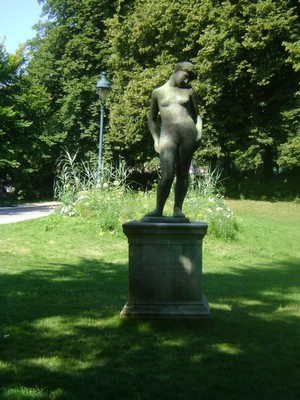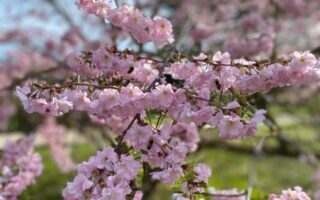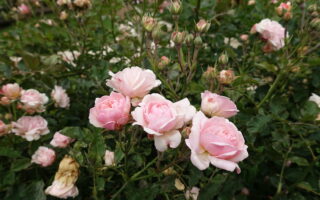Off the Beaten Track in Paris: The Parc Montsouris
- SUBSCRIBE
- ALREADY SUBSCRIBED?
BECOME A BONJOUR PARIS MEMBER
Gain full access to our collection of over 5,000 articles and bring the City of Light into your life. Just 60 USD per year.
Find out why you should become a member here.
Sign in
Fill in your credentials below.
We tend to think of “Haussmanian” Paris in terms of splendid rows of uniform, off-white, “typically Parisian” apartment buildings and grand boulevards. But a lovely, sprawling green space where the peaceful, voluptuous beauty of nature is on display, the Parc Montsouris, is another part of the legacy left by Emperor Napoleon III’s charge to Baron Haussman to transform the city in the 19th century.
It is also a delightful place to spend a morning, an afternoon, or an evening, and be surrounded by “ordinary” Parisians just enjoying their beautiful city and this wonderful green space, created for them by their last Emperor.
The Parc Montsouris, located at the southern edge of the city, in the 14th arrondissement, is one of four parks created during the Second Empire, at the four cardinal points of the city. (The others are the Bois de Boulogne, the Bois de Vincennes, and the Parc des Buttes-Chaumont). It was designed with English landscaping in mind: the Emperor said he wanted the park “to rival the London parks.” Constructed on a then-remote site that had previously included a quarry and abandoned mines, there is actually nothing at all natural about the Parc Montsouris. But you would never guess that from the way it looks: you would just think that nature is unbelievably beautiful.
 Broad paths lead through landscaped hills and spacious lawns graced with flowerbeds, as well as through wooded areas; a long rustic staircase offers strollers a beautiful view of the lake, and of a waterfall cascade. These are just some of the points of visual interest to be found in the park. Across from the main entrance to the Cité Univérsitaire, at the southern end of the park, along Blvd. Jourdan, there is a gilded statue of Thomas Paine (“Citoyen du Monde: Englishman by birth, French citizen by decree, American by adoption” it says.) There are many lovely sculptures to enjoy in this park, most though not all of them classical in both subject and style. Though it is not the most beautiful one, the one that moves me most is a simple stone slab that marks the spot where Pierre Durand, “soldat dans le 3me R.A.C.,” died on August 26, 1944, during the liberation of Paris, “tué par une bombe allemande.” It is a poignant reminder that taking Paris back from its occupiers at the end of the Second World War involved violent confrontations throughout the city, and that in that struggle, some paid the ultimate price.
Broad paths lead through landscaped hills and spacious lawns graced with flowerbeds, as well as through wooded areas; a long rustic staircase offers strollers a beautiful view of the lake, and of a waterfall cascade. These are just some of the points of visual interest to be found in the park. Across from the main entrance to the Cité Univérsitaire, at the southern end of the park, along Blvd. Jourdan, there is a gilded statue of Thomas Paine (“Citoyen du Monde: Englishman by birth, French citizen by decree, American by adoption” it says.) There are many lovely sculptures to enjoy in this park, most though not all of them classical in both subject and style. Though it is not the most beautiful one, the one that moves me most is a simple stone slab that marks the spot where Pierre Durand, “soldat dans le 3me R.A.C.,” died on August 26, 1944, during the liberation of Paris, “tué par une bombe allemande.” It is a poignant reminder that taking Paris back from its occupiers at the end of the Second World War involved violent confrontations throughout the city, and that in that struggle, some paid the ultimate price.
At the northern end of the park is a lovely lake where from morning until dusk you can expect to find Parisians of a variety of sizes, shapes, ethnicities, and ages, sitting on the benches talking quietly, or reading. A mama duck leading her family of little ducklings, a pair of black swans gracefully making their rounds, and the pleased murmuring of parents and children as they admire them, provide a very pleasant atmosphere for whiling away the time.
For children, there are a Guignol puppet theater, pony rides, a carousel, and several playgrounds. A bandshell near the open-air Pavillon Montsouris restaurant (which is itself housed in a building constructed for the 1889 Paris Exposition, now with landmark status), features free entertainment in the summer. One night as I was strolling around the lake, I happened upon a concert being given by employees of the Post Office and France Telecomm. They played a medley of Broadway tunes, followed by a medley of French pop music, including the inevitable melodies once warbled by “the little sparrow,” Piaf. It was terribly old-fashioned, completely charming, and although the music was hardly of a professional quality, it was clearly bringing delight to both the musicians and their audience. I’ve also seen morning tai chi classes, concerts by folk and rock musicians, and in one case an informal boxing match taking place in the shelter of the bandshell.
This summer, especially on weekends the park became once again just exactly the kind of urban haven it was originally designed to be, offering families stuck in an uncomfortably hot city a cool, green place in which to seek solace from the heat. And on a couple of evenings before the heat wave struck, I witnessed massive Zumba classes held on the great lawn near the western entrance to the park. The scene conveyed a joyful, multiethnic communal energy that brought smiles to the lips of passersby as well as those sitting on park benches nearby, seemingly content to simply feel the beat rather than move to it.
In keeping with the wonderful orderliness of French life, the park closes every evening promptly according to the times posted at the park entrances. (Later closing times during the summer, earlier ones as the season progresses and the sun sets earlier.) In a smoothly choreographed evening ritual, as if on cue, gendarmes appear from various locations, strolling through the center and along the perimeters of the park, gently alerting the public that the closing hour is near with their bird-like whistles. Reluctantly, people stand up, brush themselves off, and make their way to the exits, banished from this peaceful haven until the morning, when once again the gates are opened wide.
It’s a lovely place to spend an hour, a day, or an evening, as the sun goes down.
More in Parc Montsouris, Paris parks, park




